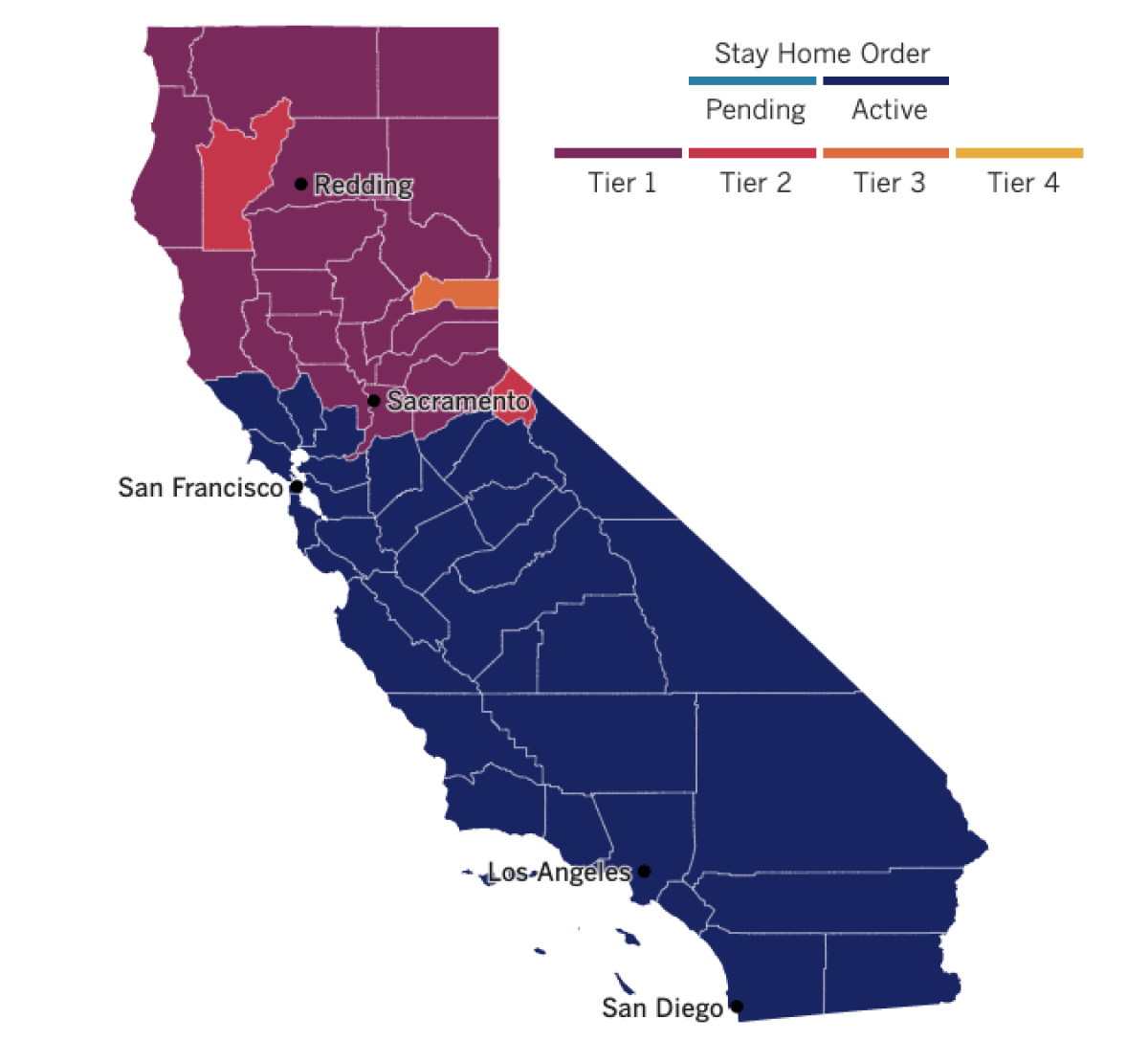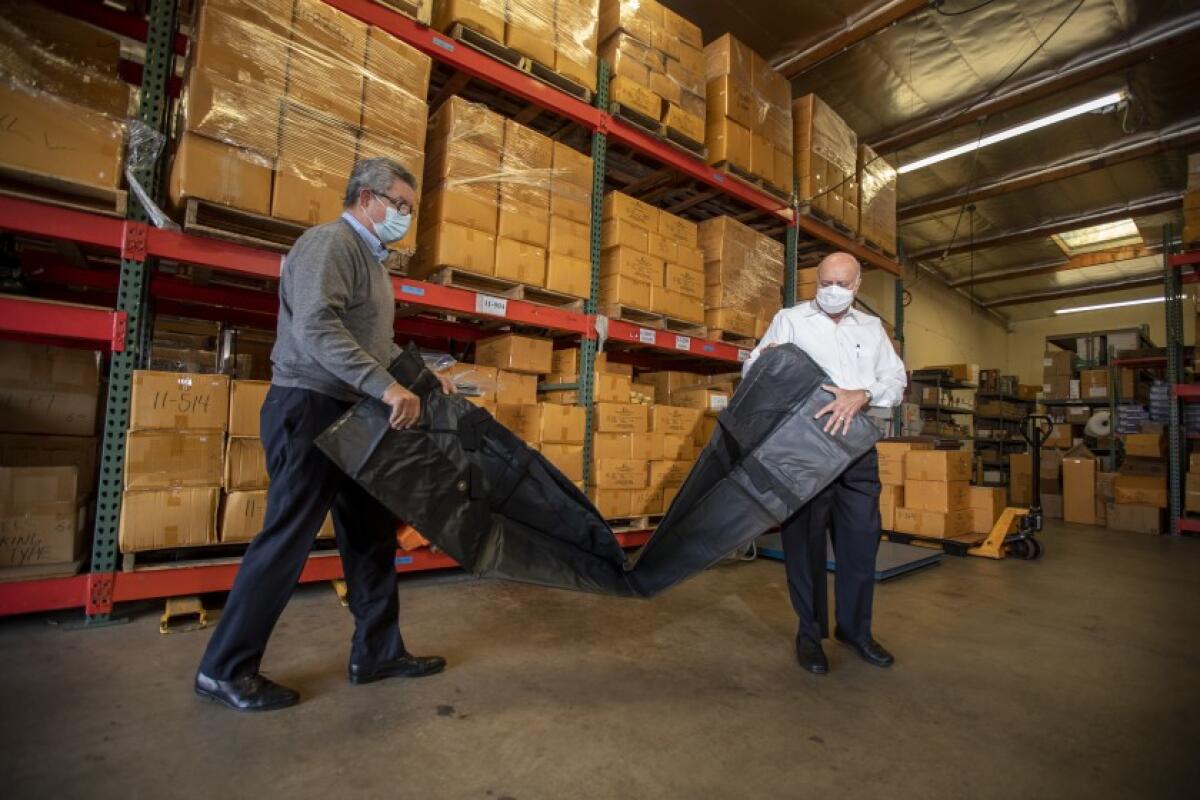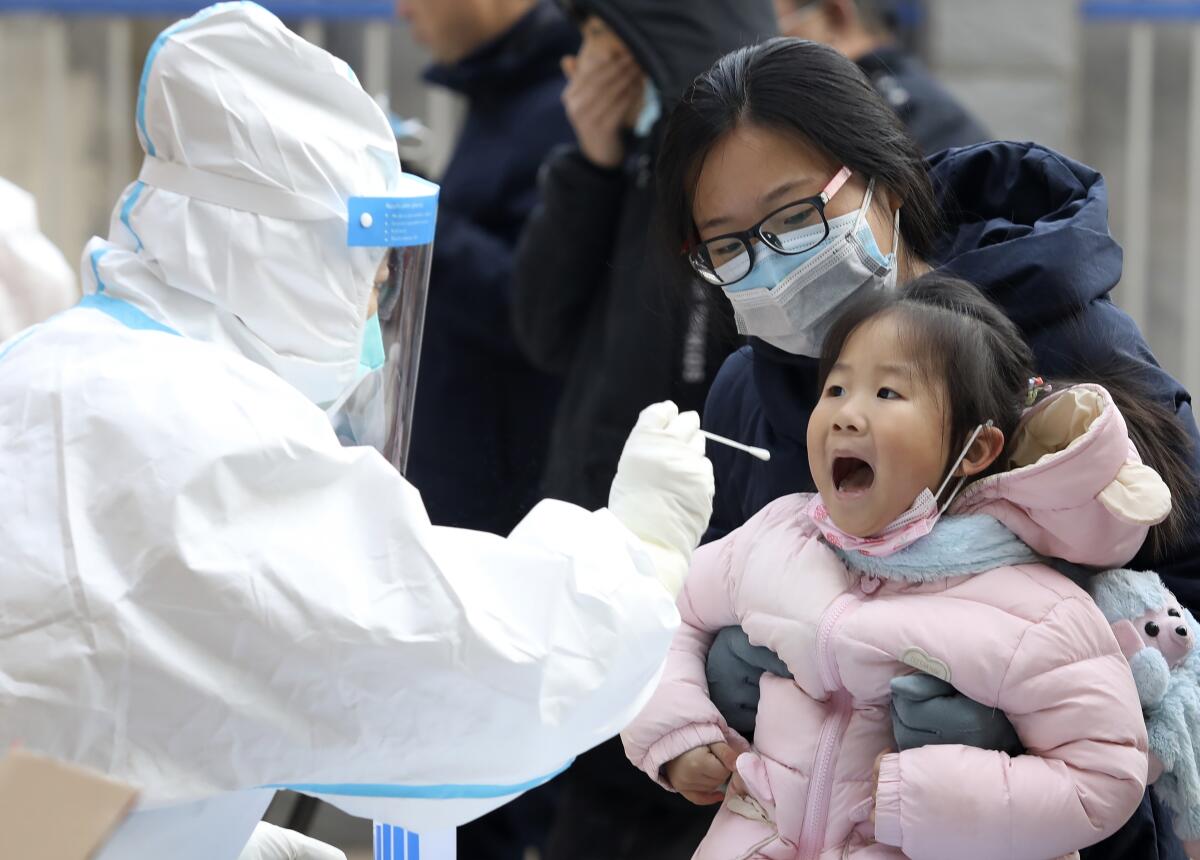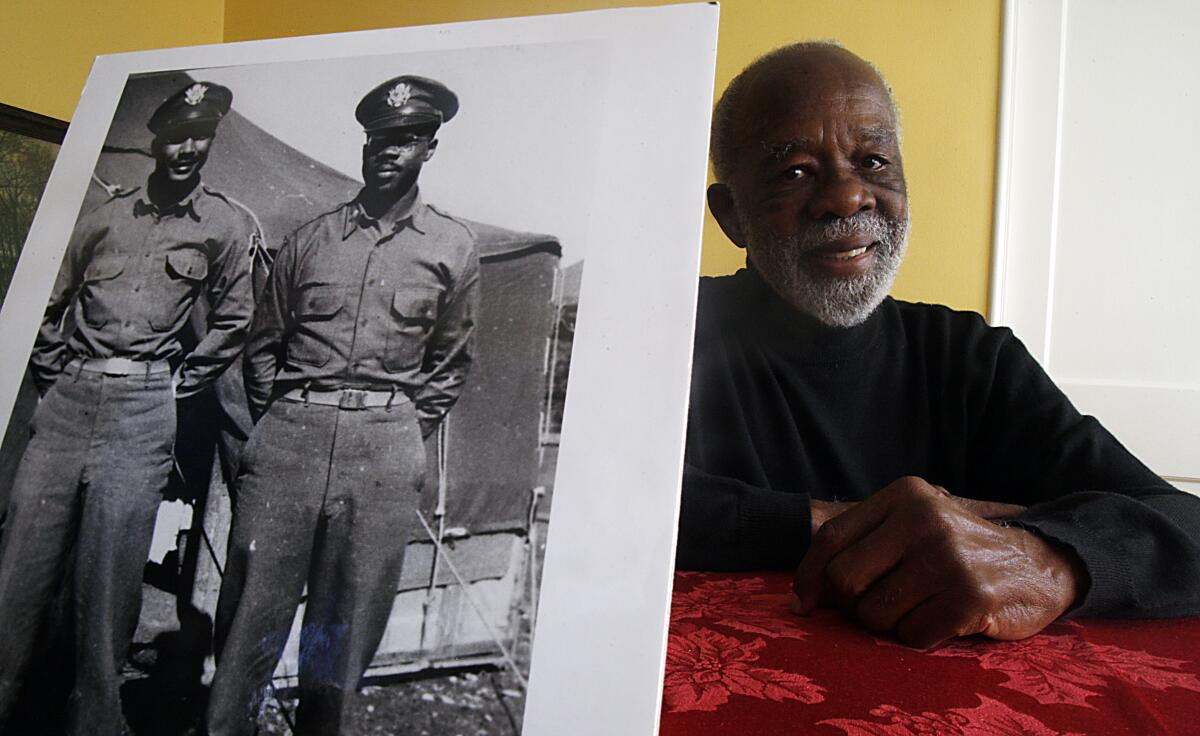Coronavirus Today: Nursing homes are left behind
- Share via
Good evening. I’m Amina Khan, and it’s Friday, Jan. 15. Because of the Martin Luther King Jr. Day holiday, we’ll next be back in your inbox on Tuesday. Here’s the latest on what’s happening with the coronavirus, plus ways to spend your weekend and a look at some of the week’s best stories.
Public health officials have been scrambling to step up their vaccination game by getting more doses out of vials and into arms. But even as they open up access to the shots, new data show they’ve failed to quickly get the lifesaving doses to the vast majority of the state’s most vulnerable population — residents of long-term care facilities, who were supposed to be the priority.
For the record:
2:20 p.m. Jan. 20, 2021The summary of an obituary for COVID-19 victim Theodore “Ted” Lumpkin Jr. implies that Barack Obama was president when he invited the former Tuskegee Airman and his fellow squadron members to his 2009 inauguration. He was not yet president when he made the request.
As of Sunday, only about 5% of those living in the 17,400 skilled nursing homes and assisted living centers enrolled in the state’s vaccination program had been inoculated, my colleague Jack Dolan reports. And only 3% of California facilities had been scheduled for their first visit from a vaccination team.
“I find that infuriating,” said Lee Collins, whose 91-year-old mother is in a Beverly Hills assisted living facility where nobody had been vaccinated as of midweek and no date had been scheduled for vaccinations to begin, according to the state data. “I thought the elderly were supposed to be the priority, but clearly that has not happened.”
The data obtained by The Times list California long-term care facilities enrolled in the vaccine program run by the Centers for Disease Control and Prevention and the pharmaceutical chains CVS and Walgreens. Nearly 360,000 people reside in these facilities, which typically house elderly folks who can no longer care for themselves. And almost none of them had been vaccinated as of Sunday.
“It’s tragic,” said Dr. Matthew Lefferman, a geriatrician whose practice consists mostly of residents in small assisted living facilities scattered across Southern California. Of his nearly 600 patients, at least 35 have died of COVID-19 since December. “We’ve known the vaccine is coming for months now, so why is it taking so long?” Lefferman asked.
It wasn’t until Monday that state officials authorized pharmacies to begin vaccinations at assisted living facilities, according to CVS. The state’s first priority was skilled nursing facilities, where residents need even higher levels of care and where the pharmacies started giving shots on Dec. 28. But the data show that even at the 855 California skilled nursing facilities in the program, only 26% of residents had been vaccinated as of Sunday.
The numbers are more encouraging in L.A. County, where health officials opted to handle vaccination in skilled nursing facilities themselves. Nearly two-thirds of residents had been vaccinated as of last week, county officials said, and they hope to inoculate the rest by next week. But the county’s assisted living facilities are still assigned to CVS and Walgreens, and as of Sunday, hardly any had begun receiving the vaccines.
The slow rollout isn’t just a problem because these folks face the greatest risk of dying of COVID-19; close to 40% of deaths nationwide have been in nursing homes. It’s also because they’re disproportionately filling ICU beds in hospitals, which are in critically short supply in many parts of the state.
As Mike Dark, an attorney at California Advocates for Nursing Home Reform, asked: “How can we manage this surge if we don’t keep those people out of the hospital?”
By the numbers
California cases and deaths as of 5:55 p.m. Friday:

Track the latest numbers and how they break down in California with our graphics.
See the current status of California’s reopening, county by county, with our tracker.


What to read this weekend
The case for mandatory vaccines
Most of the faculty at a high school in southern Minnesota can’t wait to get a COVID-19 vaccine, but one instructor says he’s not ready to take it — and he’s worried his refusal will prevent him from returning to the classroom. He’s not alone: A recent survey found that 27% of Americans are “vaccine hesitant.” Should these employees lose their jobs if they won’t do their part to reach herd immunity?
That’s a question that’s being raised as more doses become available in the coming weeks and months. As my colleagues Samantha Masunaga and Deborah Netburn report, there are no easy answers. “It’s not cut and dry,” said Ubaka Ogbogu, professor of law and bioethics at the University of Alberta in Canada. “Not all vaccines are created equal and not all diseases are created equal. It’s a very complex thing.”
For his part, Ogbogu said he’d rather take his chance with a COVID-19 vaccine that hasn’t killed anyone than with a virus responsible for more than 388,000 deaths in the U.S. alone. “My reasoning is that getting the disease itself is worse than getting the vaccine,” he said.
A business of death
While a wide swath of Californians have been slammed by the pandemic, columnist Gustavo Arellano visits one local company whose business is booming: Salam International. The Laguna Hills-based enterprise sells everything related to the care and handling of dead bodies, from autopsy tables and cadaver lifts to three-body refrigerators and embalming stations. One of the most popular items over the last 12 months has been body bags, which clients can purchase in 16 colors, including black and baby blue, and sized to fit children or adults.
If you don’t believe COVID-19 is real, Arellano says, then hear it from owner Abdul Salam. “Wake up,” said the warm-natured, 67-year-old grandfather. The coronavirus has been “good for our business, but it’s not good for the community.”
Salam appears to have seen a crisis coming sooner than many — in early 2020, he ordered double his usual supply of material for body bags. And at the start of the pandemic, Salam asked bigger clients to ration orders so that smaller ones who needed bags ASAP had access. Even though they’ve had record earnings, “the emotional toll is more,” he said. “In the end, you’re human and you feel.”

She’s on a mission
Last spring, Clarice Kavanaugh sat in her car and followed along on her phone as her best friend, Charles “Chuck” Jackson, was laid to rest in South L.A. after succumbing to COVID-19. Searching for a more profound way to honor her friend, Kavanaugh joined a clinical trial for the COVID-19 vaccine developed by AstraZeneca and the University of Oxford. While it felt like a risk, she believed it is the best way to “keep his memory alive” — and, by setting an example, the best way to help other Black people.
“People are going to die because they don’t believe in the vaccine,” said Kavanaugh, who spent years working in sales for pharmaceutical companies and now teaches at the Chicago School of Professional Psychology in L.A. “I can have a voice and be an influencer.”
Public health officials have been fretting about the high number of Americans who are reluctant to get vaccinated; Black Americans are the most wary, a distrust fed by decades of unequal access to care and a history of being subject to unethical research. As officials work to prove that the vaccines are safe and effective against a deadly disease, people like Kavanaugh may play a pivotal role in persuading more friends and loved ones to roll up their sleeves and get their shots.
Emptied villages, locked campuses, forced quarantine
China is in wartime mode as the coronavirus reemerges in areas around the country. It’s causing massive upheaval for citizens like Zhao Renmi, a woman in rural Hebei who awakened to the sound of village officials shouting that everyone had to pack and go, with no explanation of where or for how long. She obeyed, gathering her children, a backpack and two fertilizer sacks full of clothes and other supplies, as well as some steamed buns to eat on the way. “I feel like a refugee,” she said. “But I guess we obey the nation’s arrangements. If they want us to move, we move.”
This kind of acceptance of government orders has helped the country contain the pandemic and restart its economy far faster than much of the rest of the world. But this insistence on control has also blocked potentially embarrassing research into the pandemic’s origins and silenced Chinese voices that challenge the government’s positive narrative.
Residents have been questioning that narrative as they’ve been subject to haphazard evacuations and unprepared quarantine sites. One bus full of passengers from Xiaoguozhuang had to spend a frigid night onboard because no quarantine spots were available indoors. People sent to a school in Xingtai posted videos on social media of soiled bathrooms and dormitories and photos of people crowding to get water. “This isn’t quarantine, this is concentration,” one user wrote.

“Get a grip”
Columnist Mary McNamara has a warning for Angelenos who’ve gotten soft after months of being stuck at home: Get a grip, and remember how to drive. Traffic has been steadily increasing since the empty freeways early in the pandemic, but it is far from back to normal, she says: “There have always been plenty of bad drivers in Los Angeles, but now driving while oblivious threatens to become, well, another pandemic.”
In the Before Times, life on the road was a given for Angelenos, who have by and large developed a unique skillset when it comes to navigating the region’s roadways. But McNamara says she’s been witnessing and hearing about bafflingly bad — and even dangerous — driving choices with increasing frequency. Now she fears the locals have allowed their specialized abilities to atrophy. “We’re all driving like tourists,” she writes. “We’ve been sticking so close to home for so long that we’ve forgotten how to behave in the great wide world.”
A lasting legacy
One of the famed Tuskegee Airmen has been felled by COVID-19. Theodore “Ted” Lumpkin Jr., whose service as a member of the all-Black unit during World War II helped desegregate the U.S. military, has died at age 100. “We’re carrying on his [legacy], but it’s an end of an era,” said his son, Ted Lumpkin III.
A native Angeleno, Lumpkin was drafted into the military in 1942 when he was a 21-year-old student at UCLA. He was assigned to the 100th Fighter Squadron of the all-Black unit in Tuskegee, Ala. His eyes weren’t good enough to become a pilot, so he served as an intelligence officer, briefing pilots about missions during his overseas combat tour in Italy.
The Tuskegee Airmen received the highest civilian recognition in 2007 with the Congressional Gold Medal. Then-President Obama invited the surviving squadron members, including Lumpkin, to his inauguration two years later. Now, only eight original Tuskegee combat pilots and several support personnel are still alive. All are in their 90s or older.

Your support helps us deliver the news that matters most.
What to do this weekend
Get outside. Keep an eye out for migrating gray whales along the Palos Verdes Peninsula. Or start hiking segments of the 67-mile-long Backbone Trail in the Santa Monica Mountains. Subscribe to The Wild for more on the outdoors.
Go for a virtual trip. Check out this guided tour of the Kenai Fjords National Park in Alaska, where you can climb into a glacier’s crevasse, hear icebergs underwater and watch a humpback whale breach the water’s surface. Or take in the sweet songs of native birds such as apapane, elepaio and amakihi in Hawaii Volcanoes National Park. Check out Escapes for more virtual travel ideas.
Watch something great. Our weekend culture watch list includes the 2021 MLK Day Celebration, the California African American Museum’s annual remembrance of the civil rights leader that will feature a panel on Black workers and social justice, a children’s story hour and a poetry workshop. And this year, you can attend the Sundance Film Festival from anywhere. It starts later this month, but you may want to go ahead and get tickets.
Eat something great. Resolve to eat more takeout this year and try the shrimp, shishito and egg over rice at the Quiet Dumpling. Or grab an order of Egusi with goat meat from Aduke’s African Cuisine. Sign up for our Tasting Notes newsletter for more ways to expand your palate.
Go online. Here’s The Times’ guide to the internet for when you’re looking for information on self-care, feel like learning something new or interesting, or want to expand your entertainment horizons.
The pandemic in pictures
Not even the gorillas are safe. This week, we learned that multiple gorillas at the San Diego Zoo Safari Park have contracted the coronavirus in the first known instances of natural transmission to other great apes. The zoo tested the apes’ feces after two of them began coughing.
Because gorillas live together, zoo officials assume the entire troop has been exposed. Three are already showing signs of illness and are being monitored by veterinarians. The animals are believed to have caught the virus from an asymptomatic human staff member even though the zoo follows the recommended safety protocols and its employees wear personal protective equipment around wildlife.
It’s a strange but telling example of just how far and wide the virus has spread — and the unexpected ways in which it can impact our communities.
Resources
Practice social distancing using these tips, and wear a mask. Here’s how to do it right.
Watch for symptoms such as fever, cough, shortness of breath, chills, shaking with chills, muscle pain, headache, sore throat and loss of taste or smell. Here’s what to look for and when.
Need to get tested? Here’s where you can in L.A. County and around California.
Americans are hurting in many ways. We have advice for helping kids cope, resources for people experiencing domestic abuse and a newsletter to help you make ends meet.
For our most up-to-date coverage, visit our homepage and our Health section, get our breaking news alerts, and follow us on Twitter and Instagram.




